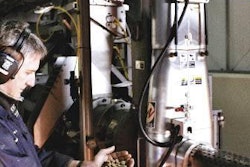
Cats have specific requirements for regulating urinary pH in the formulation of their diets. A urinary pH below 6.0 can lead to the formation of calcium oxalate uroliths (bladder stones); while a pH above 6.5 will increase the chances of struvite urolith formation (Stevenson, 2002). Research has shown that struvite uroliths can be avoided completely, by maintaining a urinary pH between 6.0 and 6.4.
Careful formulation and the use of specific ingredients (such as poultry meal or corn gluten meal) can help cats maintain an optimal urinary pH. When formulation issues arise, the use of an acidifier (either as a sprayed-on coating or ingredient) becomes necessary.
Phosphoric acid's effect on palatability
Trials were conducted at the SPF Research Center to determine the impact of phosphoric acid coating on cat kibble palatability. The goals of this research were to identify the interactions with palatability enhancers used as a coating and to identify the best way to coat kibble with phosphoric acid to maximize palatability.
Premium-quality cat kibbles were coated in a batch-coating system. Poultry fat was sprayed on at 6%, C'Sens liquid palatability enhancer (PE) at 3% and C'Sens powder PE was dusted on at 1%. The coating sequence was first fat, then the PE (liquid or powder). Some kibbles were coated with all three in the order of fat, the liquid PE then the powder PE.
Three types of trials were conducted: (1) phosphoric acid with a liquid PE; (2) phosphoric acid with a powder PE; and (3) phosphoric acid with a combination of liquid and powder PEs.
In each trial, phosphoric acid (75%) was applied at 0.5% during a different step in the coating sequence: before the fat, before the PE, after the PE and mixed with liquid (fat or PE).
Palatability test results for three trials
Palatability tests compared kibbles coated with phosphoric acid and those without phosphoric acid (the control). Two days of comparative tests were conducted at Panelis with a dry food-dedicated panel of 35 cats. The kibbles were fed at 15 days post-coating. Preference was measured by the consumption ratio.
In Trial 1, phosphoric acid was introduced at four different places during the coating process: (A) before fat coating; (B) after the fat and before liquid PE application; (C) after the liquid PE; and finally (D) mixed with the liquid PE. Each sequence was tested against its control kibble.
Consumption ratios in Trial 1 (see Figure 1) were in favor of the kibbles with phosphoric acid coated after the liquid PE or mixed with the liquid PE (sequences C and D). Results were significant and very highly significant for phosphoric acid applied prior to fat application (sequence A).
In Trial 2, phosphoric acid was sprayed on: (E) before fat coating; (F) after the fat and before powder PE application; (G) after the powder PE; and finally (H) mixed with the fat. Each sequence (E, F, G and H) was tested against its control kibble.
Consumption ratios were very highly significant for kibbles without phosphoric acid when applied before the powder PE (sequence F). The consumption ratios were significant to very highly significant in favor of the control kibble when phosphoric acid was applied before the fat (sequence E) or after the powder PE (sequence G). The level of significance of the final results show that the control is preferred (without phosphoric acid) over sequence H (phosphoric acid mixed with fat). Results also indicate that the use of phosphoric acid as a coating decreases palatability performance when combined with a powder PE (see Figure 2).
When comparing sequences G vs. F and E vs. F, palatability results indicated that there is no statistical difference between G and F, while E is highly or very highly significantly preferred over F. This means that if phosphoric acid needs to be used in a coating in combination with a dry PE, it is recommended to apply the phosphoric acid prior to the fat coating to diminish the loss of palatability performance caused by acidification.
Trial 3 studied the interaction between phosphoric acid and a combination of liquid and powder PEs. Phosphoric acid was applied at two different areas: (I) before the fat and (J) between the liquid and powder PEs.
Consumption ratios were not significant when the control kibbles were compared to sequence I (phosphoric acid coated before the fat). However, when phosphoric acid was applied between the liquid and powder PEs (sequence J), results were in favor of the control kibble (see Figure 3).
Phosphoric acid can enhance palatability when coated with liquid PE alone but will decrease palatability significantly when applied with powder PE. To improve palatability performance when powder PE is used, SPF recommends spraying phosphoric acid as far from the dry palatant as possible in the coating sequence, i.e., before the fat.
















